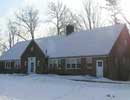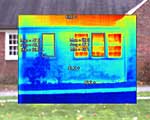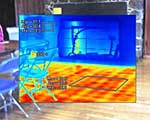 |
Field
House cozier in temperature, if not mood
 For some, it’s been a cozy annual Smith tradition.
Smith faculty and staff members gather in mid-winter in the
field house on the snow-covered athletic field and share
time together around a roaring flame in the building’s
fireplace. For some, it’s been a cozy annual Smith tradition.
Smith faculty and staff members gather in mid-winter in the
field house on the snow-covered athletic field and share
time together around a roaring flame in the building’s
fireplace.
“I have held my annual holiday party for my staff
in the field house every December because of the wonderful
stone fireplace there,” said Maureen Mahoney, dean
of the college. “The room is rustic, with a mountain
cabin feel—probably the only such place on the Smith
campus.”
Thermal photographs
of the field house show hot (orange and red)
and cool (blue) areas.

Warm windows at the
front of the building were high heat-loss areas. |

The fireplace in the
building's great room is solid blue, indicating cool
temperatures. The floor is warm. |
But following an energy
efficiency examination, Todd Holland, the Five College
energy manager, confirmed what he suspected: the field
house—and its fireplace in particular—has
been a drafty, leaky energy sapper on an inordinate level
for a long time.
The fireplace flue has had to be left open throughout the
winter to avoid dangerous situations when revelers had previously
kindled fires without opening it, Holland said.
In addition, the building’s
main room has been kept heated at about 80 degrees, even
as expensive oil heat escaped through the outdated, single-pane
windows and a non-insulated crawl space.
All that lost heat added up, noted Holland. The 3,300-square-foot
building, which is used only sporadically, cost more than
$12,000 a year in utilities, including 2,700 gallons of oil,
the equivalent of nearly three and a half average homes.
As a result of the high cost and wasteful setup, the field
house fireplace flue was permanently closed this January,
and roaring blazes are no longer an option. Also, the building
was treated to several energy efficient measures, such as
tamper-proof thermostats, wall insulation, a heat barrier
for the crawl space, and new sealing around doors and windows.
An empty refrigerator was shut off, as was an ice machine
for athletic trainers, though only during the off-season.
“I fully appreciate the need to make Smith more energy
efficient, so I support the changes that will be made in
the field house,” commented Mahoney. “But the
room will not be the same without the fireplace.”
|
 |























